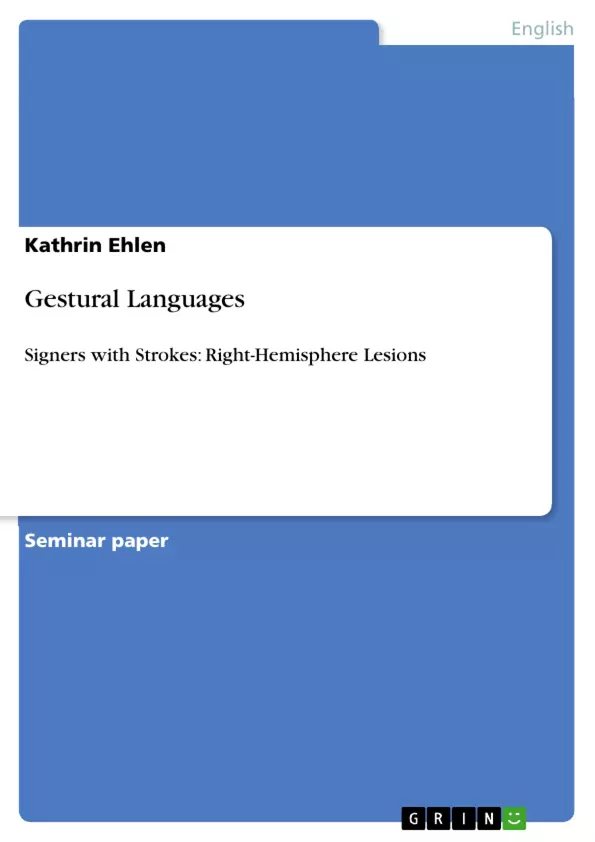In the book What the Hands Reveal about the Brain, published in 1987 by the MIT Press, the authors J. Poizner, E. Klima and U. Bellugi analyze the consequences of brain damage for deaf patients, whose primary way of communication is sign language. By analyzing them they hope to find a way to help to remediate the impairments, in the long term, but also to get some help to understand the nature of language representation in the brain. Chapter 5 of this book – the part I am occupied with – concentrates on the implications of right-hemisphere lesions for signers of ASL. Right-hemisphere lesions often produce pronounced visuospatial deficits. The question the authors raise is whether consequently linguistic deficits or even clusters of language deficits appear...
Inhaltsverzeichnis (Table of Contents)
- Introduction
- Test Persons
- Sarah M.: The Artist
- Brenda I.: The Keypunch Operator
- Gilbert G.: The Airplane Mechanic
- Test Results
- A Special Issue in Testing Signers with Right-hemisphere Lesions
- Tests of American Sign Language
- Brain, Language, and Modality
- Conclusion
- Bibliography
- Appendix
Zielsetzung und Themenschwerpunkte (Objectives and Key Themes)
This paper analyzes the consequences of right-hemisphere lesions on deaf patients who communicate primarily through sign language. It aims to understand the impact of these lesions on their linguistic abilities and to explore the nature of language representation in the brain. The paper focuses on three case studies of signers with right-hemisphere damage, examining their signing abilities, their visuospatial deficits, and the implications of their neurological findings.
- Impact of right-hemisphere lesions on sign language abilities
- Visuospatial deficits in signers with right-hemisphere damage
- Nature of language representation in the brain
- Relationship between language and modality
- Case studies of signers with right-hemisphere lesions
Zusammenfassung der Kapitel (Chapter Summaries)
- Introduction: This chapter introduces the study's focus on the impact of right-hemisphere lesions on signers of American Sign Language (ASL). It discusses the significance of examining these lesions in understanding language representation in the brain and the specific challenges faced by signers with visuospatial deficits.
- Test Persons: This chapter presents detailed case studies of three individuals with right-hemisphere lesions who are proficient signers. It covers their personal backgrounds, educational levels, and the specific neurological impairments caused by their strokes.
- Sarah M.: The Artist: This section focuses on the case of Sarah, a 71-year-old deaf woman who experienced a stroke affecting her right hemisphere. It examines her artistic abilities, visuospatial deficits, and the impact on her sign language communication. It describes her difficulties with left hemispatial neglect and how it influences her eye gaze and sign production.
- Brenda I.: The Keypunch Operator: This section profiles Brenda, a 75-year-old deaf woman who has experienced significant visuospatial impairments. It examines her spatial disorientation, difficulties navigating her surroundings, and the impact on her sign language production. It explores her left-hemispatial neglect and its subtle effects on her signing.
- Gilbert G.: The Airplane Mechanic: This section focuses on Gilbert, an 81-year-old deaf man who experienced a cerebrovascular infarct. It examines his neurological findings, specifically his left-hand awkwardness, facial weakness, and deficit in recognizing objects with his left hand. It explores how these impairments affect his sign language abilities.
Schlüsselwörter (Keywords)
This paper primarily focuses on the impact of right-hemisphere lesions on signers of American Sign Language, specifically examining visuospatial deficits and their effects on language production. It explores the nature of language representation in the brain and the relationship between language and modality. Key terms include: right-hemisphere lesions, sign language, American Sign Language (ASL), visuospatial deficits, left hemispatial neglect, linguistic impairments, language representation, brain damage, modality, case studies, and neurological findings.
- Quote paper
- Kathrin Ehlen (Author), 2006, Gestural Languages, Munich, GRIN Verlag, https://www.grin.com/document/173788



